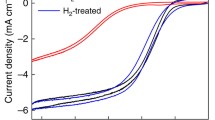Abstract
The formation of nanocarbon materials on massive nickel, nichrome, and some other alloys via the carbide cycle mechanism is reported using 1,2-dichloroethane decomposition as an example. The role of the physical stage of the carbide cycle is elucidated, and massive metal surface activation methods ensuring the realization of this stage are considered. The surface layer of massive nickel or some nickel alloys is most effectively activated by the action of chlorine resulting from the catalytic decomposition of 1,2-dichloroethane. It has been demonstrated by ferromagnetic resonance (FMR) spectroscopy that the activation of the massive metal surface in 1,2-dichloroethane decomposition to nanocarbon is due to the surface undergoing crystal chemical restructuring. The microstructuring of the surface yields fine Ni particles similar in size (0.2–0.3 μm) and shape, whose FMR spectra are anisotropic and have similar magnetic resonance parameters. Both chlorine-free and chlorinated hydrocarbons decompose over these particles via the carbide cycle mechanism. It is demonstrated that it is possible to design catalytic reactors packed with massive nickel or its alloy. The nanocarbon material obtained in such a reactor will not be contaminated by components of conventional catalyst supports (Al, Mg, etc.). The stable performance temperature of the catalyst will be increased, and this will allow the equilibrium outlet methane concentration to be reduced.
Similar content being viewed by others
References
Rakov, E.G., Usp. Khim., 2000, vol. 69, no. 1, p. 41.
Buyanov, R.A. and Chesnokov, V.V., Khim. Interes. Ust. Razv., 1995, vol. 3, p. 177.
Chesnokov, V.V. and Buyanov, R.A., Usp. Khim., 2000, no. 7, p. 675.
Buyanov, R.A. and Chesnokov, V.V., Katal. Prom-sti., 2006, no. 2, p. 3.
Mishakov, I.V., Buyanov, R.A., Zaikovskii, V.I., Strel’tsov, L.A., and Vedyagin, A.A., Kinet. Catal., 2008, vol. 49, no. 6, p. 868.
Mishakov, I.V., Chesnokov, V.V., Buyanov, R.A., and Pakhomov, N.A., Kinet. Catal., 2001, vol. 42, no. 4, p. 543.
Slinkin, A.A., Usp. Khim., 1968, vol. 37, no. 8, p. 1521.
Author information
Authors and Affiliations
Corresponding author
Additional information
Original Russian Text © Yu.I. Bauman, I.V. Mishakov, R.A. Buyanov, A.A. Vedyagin, A.M. Volodin, 2011, published in Kinetika i Kataliz, 2011, Vol. 52, No. 4, pp. 557–564.
Rights and permissions
About this article
Cite this article
Bauman, Y.I., Mishakov, I.V., Buyanov, R.A. et al. Catalytic properties of massive iron-subgroup metals in dichloroethane decomposition into carbon products. Kinet Catal 52, 547–554 (2011). https://doi.org/10.1134/S002315841104001X
Received:
Published:
Issue Date:
DOI: https://doi.org/10.1134/S002315841104001X




